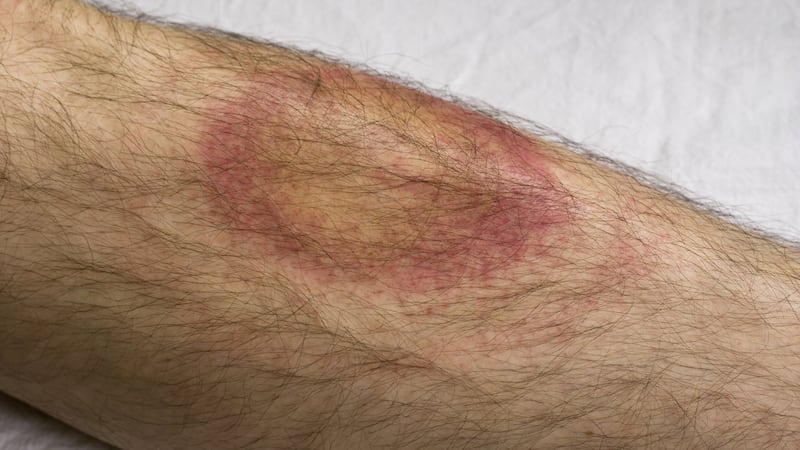Fuelled by climate change, the incidence of tick-borne Lyme disease is rising in Ireland and across the northern hemisphere — and often leaving a trail of long-term debilitating illness.
The number of Irish cases is unknown and likely to be far more than officially recorded, says infectious diseases consultant Prof Jack Lambert. Diagnosis is often imperfect and tardy, while the medical scenario can be precarious because of the strong possibility of being infected by other tick-borne diseases.
Already this year there is evidence of a record number of ticks translating into record number of bites in Ireland, Lambert says. Climate change has extended peak seasons for ticks, which brings increased risk of Lyme and other diseases, he says. Migratory patterns of birds enable ticks to transfer with ease from one region to another, while “global warming has precipitated the spread of ticks which host an increasing number of pathogens”.
Ticks — which are parasitic arachnids — usually peak in spring and autumn, favouring moist locations such as woodlands and thick grass, while they carry many different organisms, “not just Borrelia burgdorferi, the bacteria of Lyme disease”, Lambert says. Deer are known to host ticks, some carrying Lyme and other infectious agents, but many smaller animals and birds are also vessels for ticks.
READ MORE
Diagnosis of Lyme disease is imperfect: patients may experience a rash; migratory arthritis or Bell’s palsy; “but many may have atypical neurological, rheumatological or cardiological symptoms”. Untreated, it can cause brain fog and neurological symptoms mirroring the symptoms of Alzheimer’s, as well as “toxic scarring to the brain”.
Until there is better education for GPs and consultants in Ireland on the complexities of tick-borne infections, backed by better diagnostics and investment in research to improve understanding of these conditions, “patients will continue to be left undiagnosed and untreated”, he warns.
[ Lyme disease: ‘I can’t stop taking antibiotics, otherwise I’ll be bedridden very quickly’ ]
Most patients he sees have to convince their doctor to consider Lyme disease, adds Lambert, who is based at Dublin’s Mater hospital. He dreads to think of the number of cases being missed “if consultants are missing it”.
Ixodes ricinus, Europe’s predominant disease-transmitting tick species, has three forms — larvae, nymphs and adults — that feed on and infect with a flexible, spirally twisted bacterium known as a spirochaete, which can go into dormancy and recur if not treated properly. Larvae and nymphs prefer small to medium-sized animals; adults tend to favour large animals and humans.
One study found only 14 per cent of patients recalled a tick bite, only 50 per cent get the classic bullseye rash, and only about 50 per cent have a positive standard Lyme antibody test
While there are parts of Ireland where Lyme is well recognised, nowhere is immune, Lambert says. “Lyme disease does not just affect rural dwellers, dogs may bring home ticks and infect those living in urban settings also. Therefore Lyme disease will continue to be the ‘great imitator’ ... not easy to diagnose and not easy to treat.”
One study found only 14 per cent of patients recalled a tick bite, only 50 per cent get the classic bullseye rash, and only about 50 per cent have a positive standard Lyme antibody test.
“In some patients infection does not clear, triggering a cascade of infection, inflammation and dysimmunity that may cause ongoing and long-term complications,” says Lambert. “There is no current mechanism to test for co-infections; the only infection addressed in the UK and Ireland is Lyme disease. As ticks carry many pathogens, it is likely that other tick-borne infections are contributing to patients’ symptoms.”
On Lyme levels in Ireland, only cases of neuroborreliosis are reported — a neurological disorder of the central nervous system and manifestation of the disease that requires hospitalisation and a spinal tap. This represents only 10 cases annually, though there “may be”, says one health authority, up to 200 cases per year. This conflicts with modelling suggesting 2,500 annual infections, Lambert says.
Global warming has precipitated spread of ticks which host an increasing number of pathogens. “The changes in our ecosystem are pushing us, as humans, into closer contact with ticks. Apart from Borrelia, multiple other bacteria are likely infecting humans, and the reported cases to public health authorities are likely to be grossly underestimated,” he notes.
As climate impacts progress, each tick season will likely be worse than the last, Vett Lloyd, director of Lloyd Tick Lab at Mount Allison University, New Brunswick, noted recently. “As winters are getting milder and shorter, the ticks are surviving better, and they have more time to feed and have a tick romance. Once a female tick finds a male and food, she can produce for roughly 3,000 eggs. When this starts happening, [the population] explodes very quickly,” he told the Canada Press.
Prevention and early recognition is the best way to thwart the consequences of chronic Lyme/co-infections, Lambert says. “Educating the public on the importance of tick prevention, covering exposed body parts, using insect repellent, and checking for ticks upon return from the outdoors, are key messages that should be reinforced.”
Ticks should be removed from skin immediately. According to the European Centre for Disease Prevention and Control, ticks prefer soft and hairy areas. They should be pulled out with a tweezers or a specially designed tick-removal tool, “or use your fingers if you do not have the appropriate tools at hand”.

He cofounded the Lyme Resource Centre in Scotland, which seeks to improve public health by finding ways to combat all tick-borne infections. It has developed new signage with QR coding, which is being piloted in Co Clare.
As the bacteria circulate in such small numbers, it is not possible, as a rule, to develop a PCR test or antigen test sensitive enough to detect replicating organisms. “Thus we are dependent on inadequate immunological tests ... to measure the host immune systems response to an infection.”
People with suspected infections may consult different specialists “but without multisystem involvement, they may not entertain Lyme as a possible diagnosis. Treatment should be initiated immediately when a rash occurs following a tick bite, or indeed even in cases where the patient is symptomatic without a rash”, Lambert adds.
Textbooks say Lyme disease is easy to diagnose and treat, and most patients are cured with short course of antibiotics, but this is not always the case. Research suggests less than half are cured with two weeks of antibiotics.
Many patients are diagnosed with other conditions (such as chronic fatigue syndrome, ME and chronic headaches) without Lyme disease being part of the differential, Lambert says. “We are increasingly learning more about ‘long Covid’ because of the investment of research money into this condition. Sadly, no research money have been put into better understanding ‘long Lyme’.”
The scale and toll of Lyme disease underlines need for an effective vaccine. A highly-effective one, LYMErix, was developed by GlaxoSmithKline, prompting production of antibodies in the blood to kill off the tick after a bite but before it could cause an infection. Approved in 1998, some 1.5 million doses were administered but it was withdrawn in 2002 amid claims it caused arthritis — which was never proven. An anti-vax campaign led by chronic Lyme disease sufferers culminated in a class-action lawsuit accusing the manufacturer of concealing potential risks.
Some 20 years later, vaccine prospects look more promising. Pharma companies Valneva and Pfizer confirmed in February further positive results with no serious adverse events in a clinical trial for VLA15, the only potential vaccine in clinical development.
Yale University researchers have developed a novel vaccine that works in guinea pigs. Instead of triggering an immune response it prompts a quick response in the skin to components of tick saliva, limiting the amount of time ticks have to feed upon and infect the host. It deploys mRNA technology that proved so effective against Covid-19.
Scientists at UMass Medical School in Massachusetts announced last year a trial for Lyme PrEP, a preventive monoclonal antibody shot made by cloning a white blood cell.
“This is an exciting milestone,” says Prof Mark Klempner of UMass. “There is a real unmet public health need for the prevention of Lyme disease. There are more than 30 years of clinical experience that says a monoclonal antibody will be safe. The bigger question we hope to answer is how long will the antibody last in the circulation so when a tick bites you will be protected from Lyme disease.”
Lambert says a vaccine — while welcome — may be years away. He prefers to emphasise a more immediate message of getting outside, and not being afraid to do so: “This is about educating people to do so safely.”


















